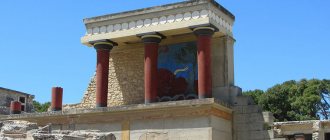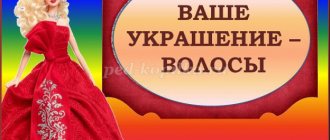Extracurricular event with presentation, 4th grade. Myths of Ancient Greece. Perseus
Scenario for an extracurricular activity on literary reading, 4th grade. Myths of Ancient Greece. Perseus
Author: Svetlana Nikolaevna Matveeva, primary school teacher, Secondary School No. 9, Ulyanovsk. Description of work: I bring to your attention a script for an extracurricular activity on literary reading for grade 4 on the topic: “Myths of Ancient Greece. Perseus". This event is part of the series “From the summer reading list.” Materials from the series can be used both in class and in extracurricular activities. The information will be useful to primary school teachers, teachers of after-school groups, teachers of children's health camps and sanatoriums. This extracurricular activity is aimed at fourth grade students. Goal: introducing children to the ancient Greek myth of Perseus. Objectives: - clarify children’s knowledge about the myths of Ancient Greece;
— broaden the horizons of younger schoolchildren; - develop expressive reading skills; — teach to analyze and compare myths; — develop children’s cognitive interest and creative abilities; — to develop a sense of responsibility for the team’s results through the use of a group form of organizing educational activities; - instill a love of reading in general; - cultivate interest in independent reading. Progress of the event
Teacher: The most interesting cultural heritage of civilizations is the myths of ancient peoples. Each country, civilization, and people composed their own myths about brave heroes, powerful gods, and all-powerful rulers of the ancient world. Ancient Greece is called the “cradle of modern civilization.” No less beautiful than the history of the country itself, its wise tales - myths. And although they were written many centuries ago, they still arouse interest. These literary works rightfully belong to the greatest cultural heritage of humanity. It should also be noted that the mythology of Ancient Greece had a huge influence on the development of culture and art throughout the world.
Teacher: Let's remember which myths of Ancient Greece we are already familiar with? (The children's answers follow). Teacher: We will continue to get acquainted with fascinating and instructive stories. Let's learn about new heroes of the myths of Ancient Greece who accomplished great feats. But first, let's remember what myths are? (The children's reasoning follows). Teacher: That's right, myths are works created by the imagination of the people. In other words, these are folk tales about natural phenomena, gods and legendary heroes. Teacher: How did myths arise? (The children's reasoning follows). Teacher: Mixing truth and fiction, the ancient Greeks invented and told each other amazing stories about the origin of the world. They answered questions: why people are brave and wise, stupid and cowardly. This is how legends about gods, heroes and wonderful creatures developed. The gods, heroes and people of the ancient Greeks embodied the good and bad properties of man. Nobility, courage, strong friendship and tender love went on a par with pathetic cowardice, greed and deceit. As you can see, guys, the myths of Ancient Greece are small stories about the magical and fairy-tale world of gods and heroes, as well as terrible monsters and animals. Thus, Greek myths (from the Greek mythos - prediction, legend) are stories about gods and heroes that have come to us from time immemorial. Now I suggest you work in groups and complete tasks. Let's remember the rules of working in a group. (The children's answers follow). Sample tasks: What popular word or expression relates to the myths of Ancient Greece? Explain its meaning. 1. Narcissistic Narcissus
2. Narcissistic Tulip 3. Narcissistic Lily of
the Valley The group, having completed the task and given the answer, receives a card and compares the correctness of their answer. Sample card with the correct answer: Narcissus is a beautiful young man, the son of the river god Kephissus. He rejected the love of the nymph Echo, for which he was punished by Aphrodite: when he saw his reflection, he fell in love with himself and stabbed himself out of hopelessness. From the drops of his blood a daffodil flower grew. His name has become a household name for a narcissistic person who admires himself.
1.Heavenly tranquility. 2. Olympian calm
3. Quiet calm
Sample card with the correct answer: Olympus is a mountain in Greece where the gods lived. The Olympians are immortal gods; in a figurative sense, people who stand above ordinary passions and worries, maintaining a calm, calm appearance and external greatness. "Olympic calm" - undisturbed calm.
1. Smart head 2. Bone leg 3. Achilles heel Sample card with the correct answer: Achilles (Achilles) is one of the strongest and bravest heroes. Achilles' mother, the goddess Thetis, wanting to make her son immortal, immersed him in the sacred waters of the River Styx; only the heel, by which Thetis held him, did not touch the water and remained vulnerable. It was on this heel that Achilles was mortally wounded by Paris's arrow. The expression “Achilles heel” means a weak, vulnerable place.
1. Trojan horse
2. African hedgehog 3. Persian cat
Sample card with the correct answer: Originated from the legends of the Trojan War . The Danaans (Greeks), after a long and unsuccessful siege of Troy, resorted to cunning: they built a huge wooden horse, left it near the walls of Troy, and themselves pretended to sail away from the shores of Troy. The Trojans, not listening to the warnings of Laocoon and the prophetess Cassandra, dragged the horse into the city. At night, the Danaans, hiding inside the horse, came out, killed the guards, opened the city gates, let in their comrades who had returned on ships and captured Troy. The expression “Trojan horse” means a secret, insidious plan; betrayal.
1. April subbotnik 2. Sisyphean labor
3. Routine work
Sample card with the correct answer: King Sisyphus of Corinth was the most cunning and intelligent of all people on earth. He built a city and reigned there for many years. With his cunning and intelligence, he acquired great wealth and ceased to respect the gods. For insulting the Olympian gods, Sisyphus was punished: he was sentenced to roll a heavy stone up the mountain, which, barely reaching the top, rolled down, and all the work had to be started again. And again Sisyphus, in sweat and dust, drags a stone up the mountain. The expression is used to mean: hard, endless and useless work.
1. Asterisk 2. Pegasus
3. Dawn
Sample card with the correct answer: Pegasus is the winged horse of Zeus; under the impact of his hoof on Mount Helicon, the source of Hypocrene was formed, which inspired poets. Pegasus is now a symbol of poetic inspiration.
Note: This task is given in a class where children are familiar with similar catchwords and expressions, and also actively use them in their speech. Teacher: Well done! We completed the task. Now let's turn to the map of the ancient world. Guys, what land is located with Ancient Greece? (The children's answers follow). Teacher: That's right, this is Egypt. Teacher: What sea washes the shores of these countries? (The children's answers follow). Teacher: That's right, the Mediterranean Sea. In addition, the hot sun of the south shines equally on them. Probably due to this, in Greek myths the ideas about the world and the meaning of nature for people are reminiscent of the myths of Ancient Egypt. The history of ancient Egypt is surrounded by secrets and mystical images. What do you imagine when you mention this fabulous civilization? (The children's reasoning follows). Teacher: That's right, these are the mysterious pyramids, the tireless Sphinx, standing on the border of two worlds and guarding the peace of the pharaoh.
Teacher: Egyptian mythology began to take on its modern appearance in the 5th – 6th millennium BC. Egyptian mythology is a collection of disparate tales that cannot be combined into a single story. Very often the same events are depicted in completely different ways, and the gods appear in different guises. Unlike Greek, ancient Egyptian mythology did not gain much popularity. How do you think the myths of Ancient Greece differ from the myths of Ancient Egypt? (The children's reasoning follows). Teacher: In Egypt, myths were only about gods, and in Greece - about gods, heroes and people. In Egypt, the gods were personified by animals. In general, the great peoples of the past left us an invaluable heritage. Ancient masters created immortal masterpieces of architecture, sculpture, and painting, which even today, thousands of years later, delight us with their beauty and perfection. (Photos appear on the board).
Architecture
Sculpture
Ancient Greek amphora
Teacher: What do you think the myths teach? (The children's reasoning follows). Teacher: That’s right, the myths of Ancient Greece teach nobility, courage and kindness, precisely because of their colorfulness and deep meaning. So, let's go to the fascinating world of gods and heroes - people and celestials. (The following is a reading of the myth of Ancient Greece “Perseus”.)
Teacher: Guys, did you like the myth? Tell us who is the main character? Describe him. Who is opposing Perseus? How did Perseus defeat the Gorgon Medusa and who helped him do it? Tell us how the meeting of Perseus and Andromeda took place? Which prediction came true and how? What feelings do you experience after reading this myth? How did the ancient Greeks view fortune telling? (The following are the children’s answers to the teacher’s questions). Teacher: Ask your questions. Note: When reading myths to children, be prepared for a lot of questions. (The teacher answers the children’s questions). Teacher: And now I suggest you watch the cartoon. (The following is a viewing of the cartoon "Perseus".)
Teacher: Did you like the cartoon? Are there any differences between the myth we read and the cartoon we watched? (The children's reasoning follows). Teacher: Guys, do not forget that myths were passed down orally from generation to generation, so sometimes the information in them has some discrepancies. And now, guys, I will ask you to complete the task - color Perseus. We will each work individually. (Individual work with children is carried out).
Teacher: The constellation Perseus is named after the famous hero of ancient myths. A star chart is an incredibly attractive and mesmerizing sight, especially in the dark night sky. I suggest you look at the map. (A map of the starry sky appears on the board.)
(View the presentation with the teacher's comments). Sample text: Against the background of the foggy road of the Milky Way, bright and slightly dim stars are clearly visible; they are the ones who make up the various constellations. One of these constellations, almost entirely located in the Milky Way, is the constellation Perseus. By the way, the arrangement of the stars in the constellation resembles a man wearing a high hat on his head. Even ancient astronomers discovered the constellation of ancient Perseus. It is located in the northern celestial hemisphere. It was visible in the starry sky from November to March. The constellation consisted of ninety stars of the second and third magnitude, which is why it was clearly visible even with the naked eye.
The constellation Perseus was observed by astronomers from different countries; everyone was attracted by this star cluster with its mystery and uniqueness. In the Middle Ages, Arab astronomers were actively involved in the study, who noticed that one eye at the head of the jellyfish remained motionless, and the other seemed to wink from time to time. This star was named Algol. The first European astronomer to deeply study the blinking Algol phenomenon was an Italian astronomer-physicist who lived in the 17th century. Only thanks to astronomers at the end of the 18th century it was possible to establish that there is a strict periodicity in the “winks” of Algol. The solution to the Algol mystery took place only at the end of the 19th century. Scientists have discovered a satellite near Algol. In the constellation Perseus, in addition to Algol, there is another variable star. It can also be observed without a telescope. She also has a satellite. Moreover, its size is smaller than the size of the star itself. Observing this pair through a telescope, astronomers call them “celestial diamonds” because of the amazing combination of colors. The main star glows with a beautiful orange light, while its small companion has a mysterious bluish glow.
In the mid-20th century, an astronomer from Holland made another interesting discovery: the stars of the second cluster scatter in all directions from its central part. There is also a fascinating sight in the constellation Perseus - a meteor shower. Starfall occurs in the summer, from about mid-July to the end of August. Peak rainfall occurs in mid-August. Astronomers named this active meteor shower the Perseid.
Teacher: And I would like to end our event like this: Ancient Greeks, ancient Greeks, The Greeks became famous to many forever.
Sometimes you even feel surprised: Well, what a famous people! They fought bravely against their enemies, They created wise myths, Prometheus, Hercules, and Atlas are familiar to any of us from childhood. And now we know
a new hero of the myths of Ancient Greece - Perseus. Teacher: Guys, share, what new did you learn today? What information do you remember most? What did you find most interesting? Where can the information you received be useful? What conclusions can be drawn? (The children's answers follow). Teacher: Ancient Greece is a rich source of myths about gods, ordinary people and the mortal heroes who protected them. Read Myths of Ancient Greece!
Thank you for the lesson! Thank you for your attention!
Presentation on the topic: Myths of Ancient Greece. Perseus
We recommend watching:
Synopsis of an integrated lesson on literary reading and art in grade 4 Synopsis of an integrated lesson on Kuprin's work "Elephant", grade 4 A system of classes aimed at developing in 4th grade students a sustainable interest in life and art. Synopsis of a lesson on literary reading (in accordance with the Federal State Educational Standard) in 4th grade
Similar articles:
Summary of a literary reading lesson in 4th grade (School 2100)
Summary of a literary reading lesson in 4th grade on the topic: Satire and humor. Nikolay Nosov “Fedina’s task”
About the life and work of Gaidar
Olympiad tasks in literary reading, grades 3 - 4
Tolstoy's fables for 4th grade
Presentation “Myths and Legends of Ancient Greece”
Performed
6th grade student
Lenkovskaya school
Kuneva Anna
In the ancient world, many people wondered how the world came to be. There were different opinions in all countries. But most people were of the same opinion: the world was created by the Gods. They were called differently in different countries.
The ancient Greeks thought that the world was created by the Titans.
The ruler of the world was Kronos (Cronus). His power was so great that he was afraid of losing it. He was so ruthless that he forced his wife, the goddess Rhea, to bring the children they were born and swallowed them. Cronus has already swallowed five: Hestea, Demeter, Hera, Hades, Poseidon. The goddess could no longer watch her husband swallow her children. On the advice of her father, Uranus hid Rhea, son of Zeus, in Crete. The goddess wrapped the stone in swaddling clothes and brought it to Kronos. Deceived by his wife, Kronos did not suspect for many years that his son Zeus was growing up in Crete. Years passed, Zeus grew up, and he decided to take revenge on his father. Zeus ascended Olympus and saw his father. And he began to fight with him, Zeus won in a terrible fight, and he forced him to spit out his brothers. And Zeus became the ruler of the world. Power was divided between the brothers Poseidon and Hades.
Zeus
-
the supreme Greek god - the father of gods and people.
His wife was Hera. Zeus often met with earthly women and appeared before them in various guises, for example, in the form of a bull, rain or a swan. Symbols: lightning, eagle, oak.
Poseidon
-
son of Kronos and Rhea, brother of Zeus, Olympian god, ruler of the sea kingdom and all its inhabitants.
Deep in the depths of the sea stands the wonderful palace of the brother of Zeus the Thunderer, the Earth shaker Poseidon. Poseidon rules over the seas, and the waves of the sea are obedient to the slightest movement of his hand, armed with a formidable trident. In the depths of the sea lives with Poseidon and his beautiful wife Amphitrite, the daughter of the prophetic sea elder Nere
Hades
–
son of Kronos and Rhea, brother of Zeus, ruler of the kingdom of the dead. He reigns deep underground. Not a single ray of sun penetrates there. The kingdom of Hades is also called Hades or Hades. The sacred river Styx flows there, the gods themselves swear by its waters. The souls of the dead fill its surroundings with loud lamentations. The huge dog Cerberus guards the entrance. Stern old Charon, the carrier of the souls of the dead, will never take a single soul to where the sun shines and laughter is heard.
Pallas Athena
-
daughter of Zeus and the Titanide Metis.
Zeus swallowed Metis because... he was predicted that her son would deprive him of power. One day Zeus had a headache, and he ordered Hephaestus to split his head with an ax. From there Athena appeared in full combat armor. She became the goddess of wisdom and war, as well as the patroness of Athens. Her symbols are the owl and the olive tree
.
Aphrodite
“Golden” is the most common epithet among the Greeks when describing Aphrodite, which means “beautiful” to them. She was associated with doves, the kissing and cooing birds of love, and with swans, known for their beauty and for pairing up forever; with flowers, especially roses, with the sweet scent of fruits, especially golden apples, and passionate dark scarlet pomegranates (a symbol shared with Persephone)
Ares
Son of Zeus and Hera. Zeus does not like his son for his bloodthirstiness. If Ares had not been his son, he would have long ago cast him into the gloomy Tartarus, where the titans languish. The heart of the ferocious Ares is pleased only by brutal battles. Furious, he rushes among the roar of weapons, screams and groans of the fighting, in sparkling weapons, with a huge shield.
Dionysus
Son of Zeus and Semele. Dionysus grew up as a beautiful young god, giving people strength and joy, giving fertility. Dionysus is the patron saint of winemaking.
His head is decorated with a wreath of grape leaves.
Hestia
–
goddess of the hearth. Every Greek city and every family had an altar dedicated to her. Tender and pure, she stood apart from the quarrels of other gods. Hestia eventually left her throne on Olympus, knowing that wherever she went she would be welcomed.
Apollo
–
son of Zeus and Latona (goddess of summer), god of light, archer, patron of predictions, arts, music and poetry, leader of the muses.
Artemis
- daughter of Zeus, goddess of the moon and hunting. Her silver arrows hit their targets accurately. She knew how to heal, protected marriage and childbirth. Artemis was the patroness of all wild animals and enjoyed hunting in her chariot drawn by deer.
Symbols: cypress tree, deer, dogs.
Hera
-
sister and wife of Zeus, patroness of women and marriage.
Beautiful and proud, she often regretted her husband's relationships with other women and persecuted them and their children. Symbols: pomegranate, peacock.
Diameter
-
goddess of agriculture and fertility.
The Greeks explained by her actions the change of seasons, the onset of autumn, the withering of nature and the resurrection of all living things in the spring. Symbols: barley or wheat ear.
The myth of Arachne
A girl named Arachne lived in Lydia. She was famous throughout Greece for her art. Out of stupidity and pride, she said that she had no equal in the art of weaving. And one day Arachne said:
- Let Pallas Athena herself come to compete with me!
And at that hour the goddess appeared before the mortal. And the competition began. Twelve gods, among them her father, Zeus, resolved this dispute. Athena wove the majestic Athenian acropolis on her bedspread and depicted a dispute with Poseidon for power over Attica. At the corners of the bedspread, Athena depicted how the gods punish people for disobedience, and around it she wove a wreath of olive leaves. Arachne depicted scenes of the gods on her veil, in which the gods are weak, obsessed with human passions. She wove a wreath of ivy all around. Athena became angry and tore up Arachne's work, and turned the girl herself into a spider. Unable to bear the shame, the girl hanged herself.







